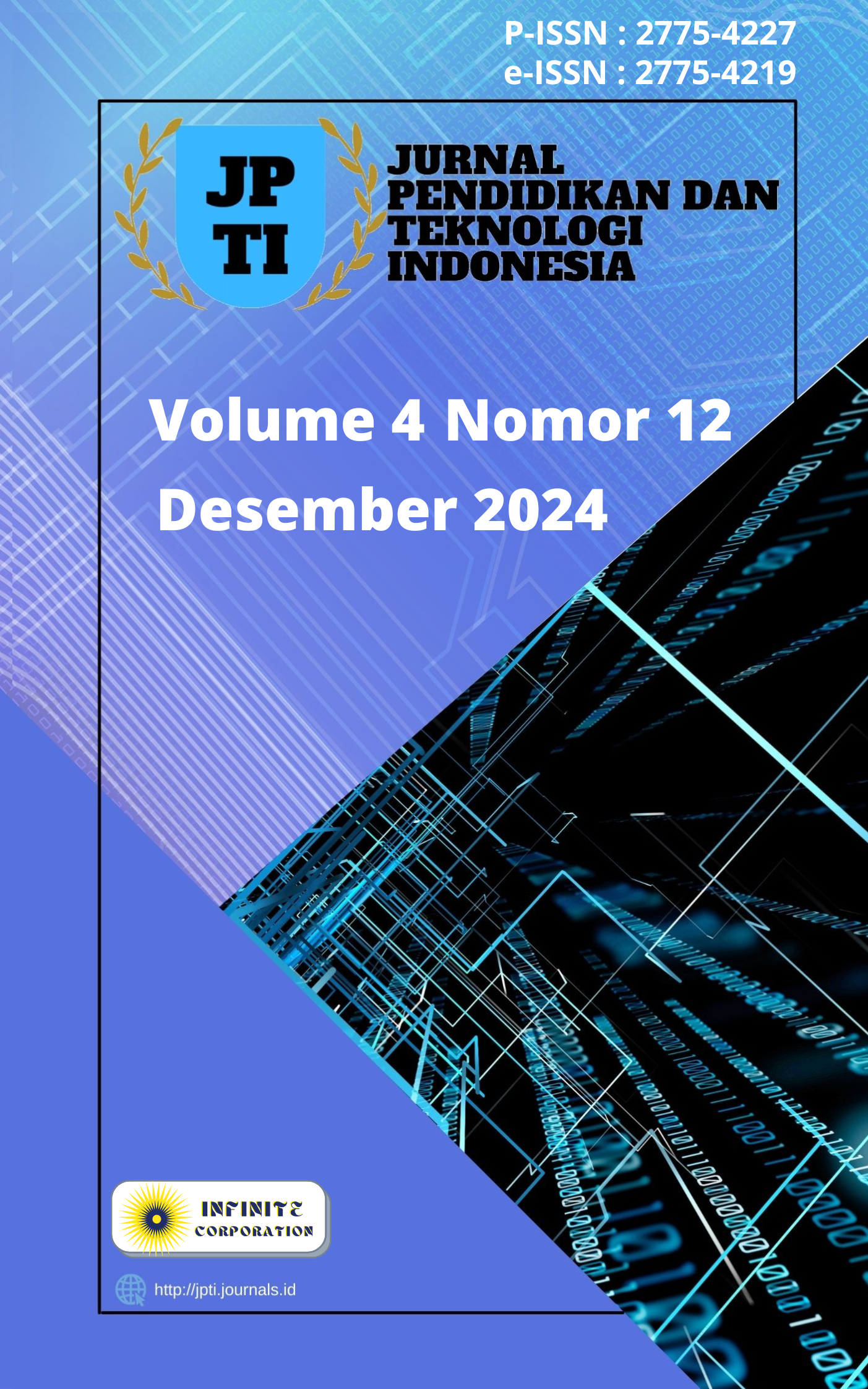Analisis Pemilihan Jurusan pada Calon Siswa SMK Negeri 4 Palembang Pada Faktor Penentu Pemilihan Jurusan Menggunakan Association Rule dan Random Forest
DOI:
https://doi.org/10.52436/1.jpti.449Kata Kunci:
Assocation Rule, Model Prediksi, Pemilihan Jurusan, Random Forest, SMK Negeri 4 PalembangAbstrak
Penelitian ini bertujuan untuk menganalisis faktor-faktor yang mempengaruhi pemilihan jurusan pada calon siswa SMK Negeri 4 Palembang menggunakan metode Association Rule dan Random Forest. Pemilihan jurusan di SMK merupakan keputusan penting yang dapat memengaruhi masa depan siswa, sehingga diperlukan pendekatan analisis yang tepat untuk memberikan rekomendasi jurusan berdasarkan faktor akademis dan non-akademis. Association Rule digunakan untuk mengidentifikasi pola-pola tersembunyi antara faktor akademis, seperti nilai mata pelajaran, dengan pilihan jurusan, sementara Random Forest diterapkan untuk membangun model prediksi yang akurat dalam menentukan jurusan yang tepat bagi siswa.Hasil penelitian menunjukkan bahwa nilai mata pelajaran tertentu, seperti Matematika dan IPA, memiliki hubungan yang signifikan dengan kecenderungan siswa memilih jurusan tertentu. Model prediksi berbasis Random Forest memberikan akurasi yang tinggi dan stabil dalam memprediksi pilihan jurusan siswa berdasarkan faktor-faktor yang telah diidentifikasi. Model ini diharapkan dapat membantu pihak sekolah dalam memberikan bimbingan karier yang lebih terarah kepada siswa, sehingga mereka dapat membuat keputusan yang lebih tepat dan sesuai dengan minat serta potensi akademik mereka.Penelitian ini memberikan kontribusi dalam pengembangan sistem pendukung keputusan di sekolah, yang dapat digunakan dalam proses Penerimaan Peserta Didik Baru (PPDB) untuk meningkatkan kepuasan dan kesesuaian pilihan jurusan dengan kemampuan siswa. Dengan demikian, hasil dari penelitian ini dapat memberikan wawasan yang bermanfaat bagi sekolah dalam meningkatkan efektivitas bimbingan karier bagi siswa SMK.
Unduhan
Referensi
S. Setiawansyah, H. Sulistiani, and V. H. Saputra, “Penerapan Codeigniter Dalam Pengembangan Sistem Pembelajaran Dalam Jaringan Di SMK 7 Bandar Lampung,” J. CoreIT J. Has. Penelit. Ilmu Komput. dan Teknol. Inf., vol. 6, no. 2, p. 89, 2020, doi: 10.24014/coreit.v6i2.10679.
SMKN4PALEMBANG, “Profil SMK Negeri 4 Palembang,” SMKN4PALEMBANG. Accessed: Sep. 15, 2024. [Online]. Available: https://smkn4palembang.sch.id/read/2/profil
V. R. Prasetyo, M. Widiasri, and M. M. Angkiriwang, “Sistem Berbasis Web Untuk Koreksi Soal Esai Assciation Rules,” Tek. J. Teknol. Inf. dan Komun., vol. 11, no. 1, pp. 62–68, 2022.
L. Ratnawati and D. R. Sulistyaningrum, “Penerapan Random Forest untuk Mengukur Tingkat Keparahan Penyakit pada Daun Apel,” J. Sains dan Seni ITS, vol. 8, no. 2, 2020, doi: 10.12962/j23373520.v8i2.48517.
F. H. Moh’d, K. A. Notodiputro, and Y. Angraini, “Enhancing interpretability in random forest: Leveraging inTrees for association rule extraction insights,” IAES Int. J. Artif. Intell., vol. 13, no. 4, pp. 4054–4061, 2024, doi: 10.11591/ijai.v13.i4.pp4054-4061.
H. Ilma, K. A. Notodiputro, and B. Sartono, “Association Rules in Random Forest for the Most Interpretable Model,” BAREKENG J. Ilmu Mat. dan Terap., vol. 17, no. 1, pp. 0185–0196, 2023, doi: 10.30598/barekengvol17iss1pp0185-0196.
M. N. F. Lubis, “Analisa jenis dan jumlah sel leukosit pada penderita tuberculosis yang menjalani pengobatan obat anti tuberculosis selama 2 bulan di Rumah Sakit Khusus Paru Medan,” Skripsi, pp. 1–46, 2021, [Online]. Available: http://repository.uma.ac.id/handle/123456789/15704
I. Fister, I. Fister, D. Fister, V. Podgorelec, I. Fister, and S. Salcedo-Sanz, “A comprehensive review of visualization methods for association rule mining: Taxonomy, challenges, open problems and future ideas,” Expert Syst. Appl., vol. 233, 2023, doi: 10.1016/j.eswa.2023.120901.
C. Fernandez-Basso, M. D. Ruiz, and M. J. Martin-Bautista, “New Spark solutions for distributed frequent itemset and association rule mining algorithms,” Cluster Comput., vol. 27, no. 2, pp. 1217–1234, 2024, doi: 10.1007/s10586-023-04014-w.
W. C. Lin et al., “Tree-Based Algorithms and Association Rule Mining for Predicting Patients’ Neurological Outcomes After First-Aid Treatment for an Out-of-Hospital Cardiac Arrest During COVID-19 Pandemic: Application of Data Mining,” Int. J. Gen. Med., vol. 15, no. September, pp. 7395–7405, 2022, doi: 10.2147/IJGM.S384959.
G. Dudek, “A Comprehensive Study of Random Forest for Short-Term Load Forecasting,” Energies, vol. 15, no. 20, p. 7547, Oct. 2022, doi: 10.3390/en15207547.
K. Rahayu, V. Fitria, D. Septhya, R. Rahmaddeni, and L. Efrizoni, “Klasifikasi Teks untuk Mendeteksi Depresi dan Kecemasan pada Pengguna Twitter Berbasis Machine Learning,” MALCOM Indones. J. Mach. Learn. Comput. Sci., vol. 3, no. 2, pp. 108–114, 2023, doi: 10.57152/malcom.v3i2.780.
J. S. Rhodes, A. Cutler, and K. R. Moon, “Geometry- and Accuracy-Preserving Random Forest Proximities,” IEEE Trans. Pattern Anal. Mach. Intell., vol. 45, no. 9, pp. 10947–10959, Sep. 2023, doi: 10.1109/TPAMI.2023.3263774.
M. Alduailij, Q. W. Khan, M. Tahir, M. Sardaraz, M. Alduailij, and F. Malik, “Machine-Learning-Based DDoS Attack Detection Using Mutual Information and Random Forest Feature Importance Method,” Symmetry (Basel)., vol. 14, no. 6, p. 1095, May 2022, doi: 10.3390/sym14061095.
Y. Kim and Y. Kim, “Explainable heat-related mortality with random forest and SHapley Additive exPlanations (SHAP) models,” Sustain. Cities Soc., vol. 79, p. 103677, Apr. 2022, doi: 10.1016/j.scs.2022.103677.
S. Amini, M. Saber, H. Rabiei-Dastjerdi, and S. Homayouni, “Urban Land Use and Land Cover Change Analysis Using Random Forest Classification of Landsat Time Series,” Remote Sens., vol. 14, no. 11, p. 2654, Jun. 2022, doi: 10.3390/rs14112654.
Adlina Khairunnisa, Khairil Anwar Notodiputro, and Bagus Sartono, “A Study of Rule Extraction from Double Random Forest to Identify the Characteristics of Working Poor in Jakarta Province, Indonesia,” Int. J. Sci. Res. Sci. Eng. Technol., pp. 258–266, 2023, doi: 10.32628/ijsrset231069.
Y. Aldi, E. Husni, and R. Yesika, “Activity of kincung flowers (Etlingera Elatior (Jack) R.M.Sm.) on total leukocytes and percentage of leukocytes in allergic male white mice,” Pharmacogn. J., vol. 12, no. 1, pp. 44–51, 2020, doi: 10.5530/pj.2020.12.8.
A. Alfando and R. Hayami, “KLASIFIKASI TEKS BERITA BERBAHASA INDONESIA MENGGUNAKAN MACHINE LEARNING DAN DEEP LEARNING: STUDI LITERATUR,” JATI (Jurnal Mhs. Tek. Inform., vol. 7, no. 1, pp. 681–686, Mar. 2023, doi: 10.36040/jati.v7i1.6486.
E. Bu’ulolo, “Algoritma K-Nearest Neighbor (K-NN) Dengan Normalisasi Max Min Untuk Menentukan Calon Mahasiswa Yang Layak Menerima KIP Kuliah Merdeka,” Simkom, vol. 9, no. 2, pp. 184–194, Jul. 2024, doi: 10.51717/simkom.v9i2.445.
L. M. Crivei, G. Czibula, and A. Mihai, “A Study on Applying Relational Association Rule Mining Based Classification for Predicting the Academic Performance of Students,” in Knowledge Science, Engineering and Management, C. Douligeris, D. Karagiannis, and D. Apostolou, Eds., Cham: Springer International Publishing, 2019, pp. 287–300. doi: 10.1007/978-3-030-29551-6_25.
A. Girdhar, H. Kapur, and V. Kumar, “Classification of White blood cell using Convolution Neural Network,” Biomed. Signal Process. Control, vol. 71, p. 103156, 2022, doi: https://doi.org/10.1016/j.bspc.2021.103156.
S. Irie, H. Aman, S. Amasaki, T. Yokogawa, and M. Kawahara, “A Comparative Study of Hybrid Fault-Prone Module Prediction Models Using Association Rule and Random Forest,” in 2023 The 5th World Symposium on Software Engineering (WSSE), New York, NY, USA: ACM, Sep. 2023, pp. 33–38. doi: 10.1145/3631991.3631996.
H. S. Kaduhm and H. M. Abduljabbar, “Studying the Classification of Texture Images by K-Means of Co-Occurrence Matrix and Confusion Matrix,” Ibn AL-Haitham J. Pure Appl. Sci., vol. 36, no. 1, pp. 113–122, 2023, doi: 10.30526/36.1.2894.
M. R. Kusnaidi, T. Gulo, and S. Aripin, “Penerapan Normalisasi Data Dalam Mengelompokkan Data Mahasiswa Dengan Menggunakan Metode K-Means Untuk Menentukan Prioritas Bantuan Uang Kuliah Tunggal,” J. Comput. Syst. Informatics, vol. 3, no. 4, pp. 330–338, 2022, doi: 10.47065/josyc.v3i4.2112.
N. T. Luchia, M. Mustakim, N. Noviarni, K. Sussolaikah, and T. Arifianto, “Feature Selection In Support Vector Machine And Random Forest Algorithms For The Classification Of Recipients Of The Smart Indonesia Program,” in 2024 International Conference on Circuit, Systems and Communication (ICCSC), IEEE, Jun. 2024, pp. 1–6. doi: 10.1109/ICCSC62074.2024.10616886.
S. Matharaarachchi, M. Domaratzki, A. Katz, and S. Muthukumarana, “Discovering Long COVID Symptom Patterns: Association Rule Mining and Sentiment Analysis in Social Media Tweets,” JMIR Form. Res., vol. 6, no. 9, pp. 1–15, 2022, doi: 10.2196/37984.
I. Permana and F. N. S. Salisah, “Pengaruh Normalisasi Data Terhadap Performa Hasil Klasifikasi Algoritma Backpropagation,” Indones. J. Inform. Res. Softw. Eng., vol. 2, no. 1, pp. 67–72, 2022, doi: 10.57152/ijirse.v2i1.311.
K. Radhika, S. Valarmathy, S. Selvarasu, K. Bashkaran, and C. Srinivasan, “Predictive Road Sign Maintenance Using Random Forest Regression and IoT Data,” in 2023 International Conference on Sustainable Communication Networks and Application (ICSCNA), IEEE, Nov. 2023, pp. 348–353. doi: 10.1109/ICSCNA58489.2023.10370728.
V. K. Rai, S. Chakraborty, and S. Chakraborty, “Association Rule Mining for Prediction of Covid-19,” Decis. Mak. Appl. Manag. Eng., vol. 6, no. 1, pp. 365–378, 2023, doi: 10.31181/dmame0317102022r.
F. Riskiyono and D. Mahdiana, “Implementation of Random Forest Algorithm for Graduation Prediction,” Sinkron, vol. 8, no. 3, pp. 1662–1670, 2024, doi: 10.33395/sinkron.v8i3.13750.
I. H. Sarker, “Machine Learning: Algorithms, Real-World Applications and Research Directions,” SN Comput. Sci., vol. 2, no. 3, pp. 1–21, 2021, doi: 10.1007/s42979-021-00592-x.
A. Sayal et al., “Neural Networks And Machine Learning,” in 2023 IEEE 5th International Conference on Cybernetics, Cognition and Machine Learning Applications (ICCCMLA), 2023, pp. 58–63. doi: 10.1109/ICCCMLA58983.2023.10346612.
M. Sholeh, D. Andayati, and R. Y. Rachmawati, “Data Mining Model Klasifikasi Menggunakan Algoritma K-Nearest Neighbor Dengan Normalisasi Untuk Prediksi Penyakit Diabetes,” TeIKa, vol. 12, no. 02, pp. 77–87, 2022, doi: 10.36342/teika.v12i02.2911.
A. Singh, “Foundations of Machine Learning,” SSRN Electron. J., no. 112, pp. 1–8, 2019, doi: 10.2139/ssrn.3399990.
A. Siswanto, A. Fadlil, and Y. Anton, “Terakreditasi SINTA Peringkat 4 Ekstraksi Ciri Metode Gray Level Co-Occurrence Matrix Untuk Identifikasi Sel Darah Putih,” JOINTECS (Journal Inf. Technol. Comput. Sci., vol. 3, no. 1, pp. 71–80, 2020.
M. K. Suryadewiansyah, T. Endra, and E. Tju, “Naïve Bayes dan Confusion Matrix untuk Efisiensi Analisa Intrusion Detection System Alert,” J. Nas. Teknol. dan Sist. Inf., vol. 8, no. 2, pp. 81–88, 2020.
R. A. F. Ulfa Windi Humaira, Nailia Nurul Hikmah, “Identifikasi Demografi Dan Faktor Pemilihan,” At-Thullab J., vol. 1, pp. 71–84, 2019.
S. Violina, N. R. Damayanti, and I. O. Herlistiono, “Detection and Classification of Blood Cancer Using Deep Learning Framework,” J. Inf. Technol. Comput. Sci., vol. 1095, pp. 159–165, 2024, doi: 10.1007/978-981-99-7077-3_16.























